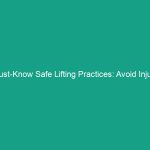Introduction
In the realm of construction, Health, Safety, and Environment (HSE) practices are paramount. The construction industry is inherently fraught with risks, making it crucial for stakeholders to prioritize Workplace Safety. One of the most effective ways to enhance Safety on construction sites is through proper Construction Site Signage and Barricading. These elements not only inform workers and visitors of present Hazards but also guide them toward Safe Practices and behaviors.
This article delves deep into essential guidelines surrounding construction site signage and barricading, providing insights into regulatory frameworks, best practices, case studies, and future trends. Understanding these components can significantly diminish accidents and enhance overall Safety, making it imperative for everyone involved in construction to be well-versed in these guidelines.
Regulatory Frameworks for Construction Site Signage and Barricading
Construction site signage and barricading are governed by various regulatory frameworks that ensure safety Standards are met across different regions. Understanding these Regulations is critical for compliance and the overall safety of the work environment.
International Standards
Several organizations set international safety standards that construction sites must adhere to. The International Organization for Standardization (ISO) has guidelines that cover safety signage and its implementation. These guidelines often specify the design, color coding, and placement of signs to ensure visibility and comprehension.
Local Regulations
In addition to international standards, local regulations play a crucial role. For instance, the Occupational Safety and Health Administration (OSHA) in the United States outlines specific signage requirements that must be followed on construction sites. Compliance with local laws not only helps avoid penalties but also promotes a culture of safety among workers.
Purpose of Regulatory Compliance
Adhering to these regulations serves multiple purposes. First, it minimizes the risk of accidents by ensuring that all workers are adequately informed about potential Hazards. Second, it fosters a culture of safety, where everyone understands their responsibilities. Lastly, it can protect companies from liability in case of incidents, making regulatory compliance a vital aspect of construction site management.
Best Practices for Construction Site Signage and Barricading
Implementing Best Practices in Construction Site Signage and Barricading can significantly enhance safety on construction sites. These practices ensure that signage is effective and that barricading is appropriately utilized to protect workers and the public.
Signage Design and Placement
Effective signage depends heavily on its design and placement. Signs should be clear, concise, and universally understandable. Using symbols and colors that are recognized internationally can help in conveying messages quickly. For example, a red sign typically indicates danger, while yellow signifies caution.
Furthermore, signs must be placed strategically at key locations where hazards are present. High-traffic areas, near machinery, and at site entrances are ideal placements. This visibility ensures that warnings are acknowledged promptly, reducing the likelihood of accidents.
Barricading Techniques
Barricading is another fundamental aspect of construction site safety. Proper barricading prevents unauthorized access to Hazardous Areas and protects workers from potential injuries. Using physical barriers like fences, cones, and tape can effectively delineate dangerous zones.
It’s essential to regularly inspect barricades to ensure they remain effective. During high winds or adverse weather conditions, barricades may shift or become damaged, so routine checks are essential to maintain safety standards.
Training and Awareness
Training workers on the importance of signage and barricading cannot be overstated. Regular safety meetings and Training sessions should include discussions about the meaning of various signs and the correct Procedures for navigating barricaded areas. This education fosters a culture of safety and ensures that everyone on site knows how to respond to different situations.
Case Studies: Successful Implementation of Signage and Barricading
Real-world examples can provide valuable insights into the effectiveness of construction site signage and barricading. These case studies highlight successful implementations and their outcomes.
Case Study 1: XYZ Construction
XYZ Construction implemented a new signage system on their sites that utilized bright colors and universally recognized symbols. The company reported a 30% reduction in minor accidents related to unawareness of hazardous areas within six months of implementation. This success was attributed to the clear communication provided by the signage.
Case Study 2: ABC Developments
ABC Developments faced challenges with unauthorized access to their construction site. By establishing a comprehensive barricading strategy, including the installation of high fencing and warning signs, they reduced unauthorized entry by 90%. This not only enhanced safety but also minimized the risk of theft and vandalism on the site.
Challenges in Construction Site Signage and Barricading
While effective signage and barricading are essential for safety, there are several challenges that construction companies may face in their implementation.
Compliance and Cost
One of the most significant challenges is ensuring compliance with all relevant regulations while managing costs. Investing in high-quality signage and barricading materials can be expensive. However, cutting corners in these areas can result in higher long-term costs due to accidents and fines.
Communication Barriers
Construction sites often employ a diverse workforce, including individuals from different linguistic backgrounds. This diversity can lead to communication barriers, where workers may not fully understand safety signs or instructions. Implementing multilingual signage can help bridge this gap, ensuring that all workers are adequately informed.
Maintenance and Monitoring
Another challenge is the ongoing Maintenance of signage and barricading. Weather conditions can wear down signs or displace barricades, making it essential to have a system in place for regular inspections. Establishing a maintenance schedule can help ensure that all Safety Measures remain effective.
Future Trends in Construction Site Signage and Barricading
As technology continues to advance, the future of construction site signage and barricading is evolving. New trends are emerging that promise to enhance safety even further.
Digital Signage
Digital signage is becoming increasingly popular on construction sites. These signs can be updated in real-time to reflect changing conditions, such as new hazards or temporary closures. This flexibility allows for more dynamic communication and can significantly improve safety awareness among workers.
Wearable Technology
Wearable technology, such as smart helmets equipped with heads-up displays, is also on the rise. These devices can provide workers with immediate alerts about potential hazards or changes in site conditions, allowing for quicker reactions and improved safety.
Data Analytics
Data analytics can play a crucial role in improving safety on construction sites. By analyzing trends in accidents and near misses, companies can identify areas where signage and barricading can be improved. This proactive approach can significantly reduce the likelihood of future incidents.
Conclusion
In conclusion, effective Construction Site Signage and Barricading are essential components of HSE practices in the construction industry. Adhering to regulatory frameworks, implementing Best Practices, and learning from case studies can significantly enhance safety on site. Despite challenges, the future holds promising advancements that can further improve these Safety Measures.
It’s crucial for all stakeholders in the construction industry to prioritize safety by investing in proper signage and barricading strategies. By doing so, we can create safer work environments and ensure the well-being of all personnel involved. Let’s commit to fostering a culture of safety and making construction sites safer for everyone.


